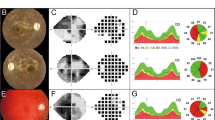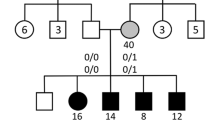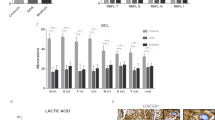Abstract
Wolfram syndrome (WFS; OMIM 222300) is an autosomal recessive neurodegenerative disorder defined by young-onset non-immune insulin-dependent diabetes mellitus and progressive optic atrophy. Linkage to markers on chromosome 4p was confirmed in five families. On the basis of meiotic recombinants and disease-associated haplotypes, the WFS gene was localized to a BAC/P1 contig of less than 250 kb. Mutations in a novel gene (WFS1) encoding a putative transmembrane protein were found in all affected individuals in six WFS families, and these mutations were associated with the disease phenotype. WFS1 appears to function in survival of islet ß-cells and neurons.
This is a preview of subscription content, access via your institution
Access options
Subscribe to this journal
Receive 12 print issues and online access
$209.00 per year
only $17.42 per issue
Buy this article
- Purchase on SpringerLink
- Instant access to full article PDF
Prices may be subject to local taxes which are calculated during checkout






Similar content being viewed by others
References
Wolfram, D.J. & Wagener, H.P. Diabetes mellitus and simple optic atrophy among siblings: report of four cases. Mayo Clin. Proc. 13, 715–718 ( 1938).
Rando, T.A., Horton, J.C. & Layzer, R.C. Wolfram syndrome: evidence of a diffuse neurodegenerative disease by magnetic resonance imaging. Neurology 42 , 1220–1224 (1992).
Barrett, T.G. & Bundey, S.E. Wolfram (DIDMOAD) syndrome. J. Med. Genet. 34, 838–841 (1997).
Karasik, A. et al. Genetically programmed selective islet ß-cell loss in diabetic subjects with Wolfram's syndrome. Diabetes Care 12, 135–138 (1989).
Fraser, F.C. & Gunn, T. Diabetes mellitus, diabetes insipidus, and optic atrophy. An autosomal recessive syndrome? J. Med. Genet. 14, 190–193 ( 1977).
Raiti, S., Plotkin, S. & Newns, G.H. Diabetes mellitus and insipidus in two sisters. Br. Med. J. 2, 1625–1629 (1963).
Barrientos, A. et al. Autosomal recessive Wolfram syndrome associated with an 8.5-kb mtDNA single deletion. Am. J. Hum. Genet. 58, 963–970 (1996).
Hoffmann, S. et al. Wolfram (DIDMOAD) syndrome and Leber hereditary optic neuropathy (LHON) are associated with distinct mitochondrial DNA haplotypes. Genomics 39, 8–18 ( 1997).
Polymeropoulos, M.H., Swift, R.G. & Swift, M. Linkage of the gene for Wolfram syndrome to markers on the short arm of chromosome 4. Nature Genet. 8, 95–97 (1994).
Collier, D.A. et al. Linkage of Wolfram syndrome to chromosome 4P16.1 and evidence for heterogeneity. Am. J. Hum. Genet. 59, 855–863 (1996).
Kruglyak, L., Daly, M.J., Reeve-Daly, M.P. & Lander, E.S. Parametric and nonparametric linkage analysis: a unified multipoint approach. Am. J. Hum. Genet. 58, 1347– 1363 (1996).
Kozak, M. Interpreting cDNA sequences -- some insights from studies on translation. Mamm. Genome 7, 563–574 (1996).
Kyte, J. & Doolittle, R.F. A simple method for displaying the hydropathic character of a protein. J. Mol. Biol. 157, 105–132 (1982).
Ishihara, H. et al. Pancreatic ß-cell line MIN6 exhibits characteristics of glucose metabolism and glucose-stimulated insulin secretion similar to those of normal islets. Diabetologia 36, 1139–1145 (1993).
Ries, S. et al. Different missense mutations in histidine-108 of lysosomal acid lipase cause cholesteryl ester storage disease in unrelated compound heterozygous and hemizygous individuals. Hum. Mutat. 12, 44–51 (1998).
Swift, R.G., Polymeropoulos, M.H., Torres, R. & Swift, M. Predisposition of Wolfram-syndrome heterozygotes to psychiatric illness. Molecular Psychiatry 3, 86–91 (1998).
Blackwood, D.H.R. et al. A locus for bipolar affective disorder on chromosome 4p. Nature Genet. 12, 427–430 (1996).
Rotter, J.I., Vadheim, C.M. & Rimoin, D.L. in Diabetes Mellitus. Theory and Practice. (eds Rifkin, H. & Porte, D. Jr) 378–413 (Elsevier Science Publishing, New York, 1990).
Mein, C.A. et al. A search for type 1 diabetes susceptibility genes in families from the United Kingdom. Nature Genet. 19, 297–300 (1998).
Concannon, P. et al. A second-generation screen of the human genome for susceptibility to insulin-dependent diabetes mellitus. Nature Genet. 19, 292–296 (1998).
Pratley, R.E. et al. An autosomal genomic scan for loci linked to prediabetic phenotypes in Pima Indians. J. Clin. Invest. 101, 1757 –1764 (1998).
Hanis, C.L. & Bell, G.I. Hot papers - human genetics - a genome-wide search for human non-insulin dependent (type 2) diabetes genes reveals a major susceptibility locus on chromosome 2. Scientist 12, 11 (1998).
Polonsky, K.S., Sturis, J. & Bell, G.I. Non-insulin-dependent diabetes mellitus - A genetically programmed failure of the ß cell to compensate for insulin resistance. New Engl. J. Med. 334, 777– 783 (1996).
Groop, L.C. & Tuomi, T. Non-insulin-dependent diabetes mellitus - a collision between thrifty genes and an affluent society. Ann. Med. 29, 37–53 ( 1997).
Nanko, S., Yokoyama, H., Hoshino, Y., Kumashiro, H. & Mikuni, M. Organic mood syndrome in two siblings with Wolfram syndrome. Br. J. Psychiatry 161, 282 (1992).
Higashi, K. Otologic findings of DIDMOAD syndrome. Am. J. Otology 12, 57–60 (1991).
Maruta, K., Sobue, G., Goto, S., Nakao, N. & Takahashi, A. Three sisters suffering from Wolfram (DIDMOAD) syndrome. Clin. Neurol. 27, 725– 732 (1987).
Nestorowicz, A. et al. Genetic heterogeneity in familial hyperinsulinism. Hum. Molec. Genet. 7, 1119–1128 (1998).
Inoue, H. et al. Isolation, characterization, and chromosomal mapping of the human insulin promoter factor 1 (IPF1) gene. Diabetes 45, 789–794 (1996).
Wilson, R.K. & Mardis, E.R. in Genome Analysis: A Laboratory Manual (eds Birren, B., Green, E., Heiter, P. & Myers, R.) in press.
Chomczynski, P. & Sacchi, N. Single-step method of RNA isolation by acid guanidium thiocyanate-phenol-chloroform extraction. Analytical Biochem. 162, 156– 159 (1987).
Ferrer, J. et al. Mapping novel pancreatic islet genes to human chromosomes. Diabetes 46, 386–392 (1997).
Chadwick, R.B., Conrad, M.P., McGinnis, M.D., Johnston-Dow, L. & Kronick, M.N. Heterozygote and mutation detection by direct automated fluorescent DNA sequencing using a mutant taq DNA polymerase. BioTechniques 20, 676– 683 (1996).
Acknowledgements
We are grateful to the patients, their families and physicians for participating in this study. We acknowledge S. Nanko, T. Ikeuchi, K. Yamamoto, Y. Hoshino, H.Yokoyama, S. Hoshino, S. Niwa and N. Nakao for care of patients, compiling clinical data and obtaining patient samples. The authors thank Y. Kora, Y. Mizukami, C. Welling, B. Wilson and C. Iannotti for technical assistance, and J. Wokurka for preparation of the manuscript. We also thank J. Rice for initial help with power calculations for linkage analysis, P. Goodfellow for helpful advice throughout the project and C. Helms for construction of the meiotic map of chromosome 4p. S. Chissoe, R. Wilson and E. Mardis gave guidance with the shotgun sequencing. This work was supported in part by NIH grants DK16746 and DK20579 (M.A.P.), DK07120 (P.B.), HG00100 (H.D.-K.), and DK38494 (M.M.), Grant-in-Aid for Creative Basic Research (10NP0201) from the Ministry of Education, Science, Sports and Culture of Japan (Y.O.), Grants-in-Aid for Scientific Research (10671074) from the Ministry of Education, Science, Sports and Culture of Japan (Y.T.) and a Mentor-Based Fellowship Award from the American Diabetes Association (Y.T., H.I.).
Author information
Authors and Affiliations
Corresponding author
Rights and permissions
About this article
Cite this article
Inoue, H., Tanizawa, Y., Wasson, J. et al. A gene encoding a transmembrane protein is mutated in patients with diabetes mellitus and optic atrophy (Wolfram syndrome). Nat Genet 20, 143–148 (1998). https://doi.org/10.1038/2441
Received:
Accepted:
Issue Date:
DOI: https://doi.org/10.1038/2441



